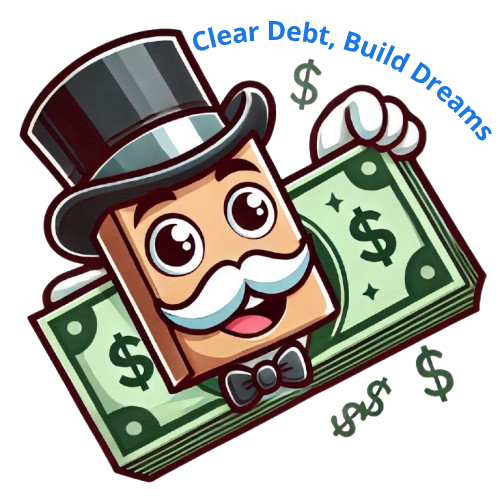Starting down the road to financial freedom begins with understanding where you stand with your debt. To paint a clear picture, evaluate your current financial state. List all your credit card balances, noting the amount you owe for each card. This gives you a sense of the total amount and helps see which debts are highest.
Knowing your interest rates is crucial. Credit cards often come with varying rates, and these can drain your funds faster than you might realize. Higher rates mean you pay more over time, making tackling these debts a priority. Keep track of each card’s rate to strategize effectively.
Minimum payments might seem like a relief at the end of the month, but they’re tricky. Paying only the minimum extends the life of your debt and maximizes the interest you pay. This can keep you in a cycle that feels never-ending.
Your credit card debt affects more than just your monthly budget; it impacts your credit score significantly. High balances relative to your credit limit can hurt your score, which affects your ability to get loans at favorable rates in the future. It’s essential to keep an eye not just on your debt total, but how it’s affecting your overall financial health.
Diving into why the debt piled up can provide insights for managing money better in the future. Whether it’s unexpected expenses, overspending, or something else, identifying these causes can help prevent you from falling back into debt once you’ve paid it off. Recognizing the patterns lets you make proactive changes.
Here’s a little transparency: Our website contains affiliate links. This means if you click and make a purchase, we may receive a small commission. Don’t worry, there’s no extra cost to you. It’s a simple way you can support our mission to bring you quality content.”
Contents
Creating a Budget: Mapping Out Your Path to Financial Stability
Crafting a budget is like drawing a roadmap to help guide your financial journey. The first step in this process is making it realistic. List all your income sources, then subtract necessary expenses like rent, groceries, and transportation. The balance will show you what you can feasibly use to tackle your debt each month.
Tracking where your money goes helps pinpoint areas where you might be overspending. Consider using apps or tools to monitor your daily expenses. These insights can shape a budget that truly reflects your lifestyle, helping you find opportunities to save without feeling deprived.

When deciding what costs to cut, focus on prioritizing essentials. Maybe cooking at home more often replaces frequent dining out, or consider cheaper entertainment options. Small changes can accumulate into significant savings that push you closer to financial stability.
Nobody wants to cut all their pleasures, so think of creative ways to have fun on a budget. Discounts, deals, or free local events can offer enjoyable experiences without overextending your finances. Finding joy without extra spending reinforces positive budgeting habits.
An emergency fund, while tackling debt, might sound counterintuitive, but it’s a safety net that keeps you from slipping back into old habits. Life throws curveballs; having even a small cushion shields you from reaching for credit cards when surprises arise. This balance between saving and debt repayment bolsters your overall financial framework.
Coinscaddy
Interactive Debt Repayment Calculator
Managing credit card debt can feel overwhelming, but a clear understanding of how to tackle it can make all the difference. That’s why we’ve included an Interactive Debt Repayment Calculator to help you see how long it will take to pay off your $8,000 credit card debt and how much interest you’ll pay over time. You can experiment with different monthly payments or even add extra contributions to explore various repayment strategies.
How to Use the Calculator
- Enter Your Debt Amount: Defaulted to $8,000, but you can input your actual debt amount.
- Input Your Interest Rate: Use the annual percentage rate (APR) for your credit card.
- Set Your Monthly Payment: Use the sliders to adjust the amount you can afford each month.
- Optional: Add Extra Monthly Contributions: See how even small additional payments can accelerate your payoff timeline.
Try It Now
Use the calculator below to create a debt repayment plan that works for you:
Open Debt Repayment Calculator
How to Use the Calculator
- Enter Your Debt Amount: Defaulted to $8,000, but you can input your actual debt amount.
- Input Your Interest Rate: Use the annual percentage rate (APR) for your credit card.
- Set Your Monthly Payment: Use the sliders to adjust the amount you can afford each month.
- Optional: Add Extra Monthly Contributions: See how even small additional payments can accelerate your payoff timeline.
Example Results
- Current Scenario: Paying $200/month on an $8,000 balance with a 15% interest rate would take you over 5 years to pay off and cost $3,522 in interest.
- Improved Scenario: Increasing your payment to $300/month reduces your payoff time to 3 years and cuts your interest down to $1,959.
Start optimizing your debt repayment plan today! Click the calculator above to begin.
Why This Tool Matters
This calculator gives you real-time feedback on your repayment strategy, helping you make informed decisions about managing your debt. It’s not just a tool—it’s your first step toward financial freedom.
💡 Tip: Experiment with increasing your monthly payments by as little as $50 to see how much faster you can become debt-free!
Choosing the Right Debt Repayment Strategy
Once you’ve got a handle on your budget, selecting the right strategy to pay down debt becomes crucial. Two popular methods stand out: the Snowball and the Avalanche. Each fits different financial goals and personalities, so choose what aligns best with your situation.
The Snowball Method has you paying off your smallest debt first, giving you quick wins that boost your motivation. By clearing smaller debts, you can build confidence and make noticeable progress quickly. As each debt disappears, the money you free up can tackle the next one on the list.
Alternatively, the Avalanche Method focuses on eliminating the debt with the highest interest rate first. While it might take longer to see visible progress, this approach saves more money in the long run by cutting down on the interest you accrue. This strategy works best if you’re committed to the long-term financial health perspective.
Balance transfers and debt consolidation are other options to consider. Transferring balances to a card with a lower interest rate or consolidating several debts into a single payment might alleviate some pressure. Be mindful of any fees involved, and ensure the terms truly benefit your situation.
Utilize any unexpected windfalls to their fullest potential. Whether it’s a bonus from work, a tax return, or a generous gift, directing these funds directly to your debt can expedite the repayment process. It’s a rewarding feeling to see such milestones whip down that debt figure.
Finally, if managing debt becomes overwhelming, professional help might be the way to go. Credit counseling can offer tailored advice and might even negotiate better terms with creditors. Taking charge of your financial well-being by seeking expert assistance isn’t a sign of weakness—it’s a strategic step forward.
Maximizing Income Streams: Boosting Your Debt Repayment
Finding additional income sources can accelerate your path to being debt-free. A side hustle leverages skills you already have into extra cash, whether it’s freelancing, tutoring, or even pet sitting. Choose something that fits your schedule and doesn’t add unnecessary stress.
Discussing a raise or promotion at work might be daunting, but it can yield substantial long-term benefits. Preparing well-researched points about your contributions and market salary trends can strengthen your case when talking to your boss.

Passive income opportunities exist beyond traditional routes like renting out property. Consider peer-to-peer lending or setting up a small e-commerce store. These options require different levels of initial effort but can provide ongoing revenue.
Decluttering can lead to financial gain by selling items you no longer need. Online marketplaces or local sales can turn unused things into cash that supports your debt payment efforts.
Freelancing offers flexibility and the chance to monetize hobbies or skills like graphic design, writing, or digital marketing. It’s about finding the right balance between time and rewards, contributing to both your finances and personal growth.
Staying Motivated: Building Habits for a Debt-Free Life
Keeping motivation high is key to staying on track with debt repayment. Setting achievable milestones helps break down the larger goal into manageable parts. Celebrate these wins, as every cleared debt brings you one step closer to financial independence.
Monitoring progress regularly is essential. It keeps your strategy flexible, allowing you to make adjustments when things don’t go as planned. Reviewing your budget and strategies periodically ensures you’re still on the most efficient path for debt reduction.
Engage a financial accountability partner—someone to check in with about your financial goals and keep you encouraged. Sharing your journey can make the process less isolating and even more rewarding.
Adopting sustainable financial habits requires a mindset shift. It’s about creating a lifestyle that prioritizes financial health without feeling restrictive. When new habits start to feel natural, the changes become a part of your everyday life.
Staying the course during challenges is vital. Understand that setbacks might happen, but resilience and sticking to your plan will bring you back stronger. With the right mindset, every challenge is just another opportunity to refine your journey to a debt-free life.


Your article on paying off $8000 in credit card debt is both practical and motivational. The step-by-step approach you outline is very accessible, making it easier for individuals to implement these strategies in their financial planning. The advice given in your article on prioritizing high-interest debt first is very sound, as it can significantly reduce the total amount of interest paid over time.
Creating a budget and sticking to it is another crucial point. It’s often easy to overlook the small, everyday expenses that add up, but your tips on tracking spending and cutting unnecessary costs are great reminders of how to stay disciplined and focused on financial goals.
How do you recommend handling unexpected expenses that might arise during the debt repayment process. Do you have any strategies for staying on track even when faced with unforeseen financial challenges? Your insights on this would be greatly appreciated.
Thank you for your insightful comment, Investor!
Dealing with unexpected expenses can complicate debt repayment, but there are strategies to help you stay on course. One effective approach is to maintain a small emergency fund; even having $500 to $1,000 can significantly ease the burden of unforeseen costs without increasing your debt.
Additionally, consider allocating a small portion of your budget each month for miscellaneous expenses. This can serve as a cushion for any surprises, allowing you to continue your debt payments without interruption.
If an unexpected cost arises, look for ways to reduce spending on non-essentials like dining out or entertainment for that month. This will help you remain committed to your financial goals while minimizing any setbacks.